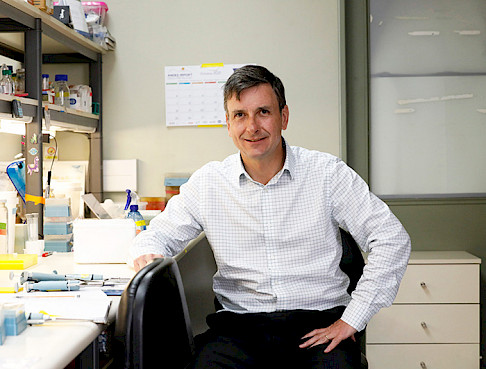UC Chile Researchers Discover Key to Amphibian Spinal Cord Regeneration
Based on a study on frogs, a team of researches lead by Professor of Biological Sciences Juan Larraín, observed stem cells' ability to regenerate the spinal cord, and found a signal that activates the regenerative process. This could be a significant step towards developing research in mammals.

photo_camera The research led by Professor Juan Larraín studied the mechanism that explains the regenerative ability of the spinal cord in frogs, discovering the signal that activates the process. (Photo: iStock)
The spinal cord is the part of the nervous system that carries messages between the brain and the rest of the body. Even though the brain is well protected by its vertebrae, if someone were to suffer a severe blow to this area, such as from a car accident or sports accident, the neurons and nerves that connect the brain to the rest of the body would likely be damaged. The result would be paralysis of the lower half of the body (paraplegia) or from the neck down (quadriplegia).
Humans, as well as mammals in general, do not have the ability to regenerate their spinal cord nervous system neurons, which means that when damaged, they cannot be repaired.
However, a team from the Laboratory of Developmental and Regenerative Biology, led by Juan Larraín, professor at the Faculty of Biological Sciences, discovered something incredible: when studying a group of frogs, they realised that when they are tadpoles (larval stage) they have the ability to completely regenerate the spinal cord.
The work, which was supported by the Centre for Ageing and Regeneration (CARE), and appears in the prestigious NPJ Regenerative Medicine Journal, which is published by Nature Publishing Group.
“We researched the mechanisms that allow frogs, in their tadpole stage, to be able to regenerate their spinal cord. We studied the mechanism at the cellular and genetic level that explains why this animal has the capacity of regeneration,” said the researcher.
Super-Powerful Stem Cells
The team developed a model that clearly shows that when tadpoles suffer damage to their spinal cord, they become paralyzed, but after a few days they regain mobility until they are able to swim again as if nothing had happened. However, if a tadpole suffers an injury after it has entered the juvenile or adult stage, it is not able to recover movement. "It behaves like a mammal," Larraín added.
Why does this happen?
"What we have found is that tadpoles have large numbers of neural stem cells. When injured, they are able to generate a new neuron and replace the damaged one. However, these cells decrease as the tadpole continues to undergo metamorphosis and practically disappear when it grows into a frog," explained the professor.
In other words, regeneration occurs because stem cells are activated.
“This is a fascinating model because it allows for a lot of comparative studies. You can identify, at the genetic and molecular level, the mechanisms by which this animal regenerates and others do not. What happens with the spinal cord also happens with the heart and various other tissues, which regenerate in the first stage, but not afterwards."
The Signal

The researchers already knew about the function of neural stem cells from previous studies.
“What we identified is the signal that activates these cells. When the animal suffers an injury, a molecular signal—called mTORC—is activated, which will tell the neural stem cells: hey, there was serious damage here, activate, start generating new neurons,” explained the researcher.
In other words, the important finding was discovering the signal that activates the entire regenerative process.
And how did they discover it?
Thanks to massive transcriptome sequencing technology. The scientists used state-of-the-art technology that allows massive sequencing of all the genetic material that is in these stem cells. This task was made possible thanks to international collaboration with Mike Gilchrist, a researcher at the Francis Crick Institute in London, who, in addition to his intellectual work, provided access to high-cost, top-of-the-line equipment.
"What we do is massive sequencing in injured and uninjured animals, and by comparing the genetic information in both situations, you start to identify which genetic processes are reactivating or are changing when injured. So, using bioinformatics, we identified this signalling pathway.”
New Questions
“We humans have very few stem cells in our spinal cord. In that sense, we resemble mature frogs. It is not like we have no stem cells; we have some," clarified the researcher.
He continued: “What is the point in knowing that the signal we identified activates this regeneration process in tadpoles? One might ask, hypothetically, what would happen if we were to find a way to activate this pathway in the marrow of a mouse, or a human being.”
What would happen if exogenously, for example, through a drug, it were possible to activate the few neural stem cells or stem cells that mammals possess? This would lead to new hypotheses. Could its regenerative ability be improved?
"We now know that if we activate this signal (mTORC), it's going to allow regeneration to occur in tadpoles. The question is: if I activate that pathway in the spinal cord of a mouse that has suffered spinal cord damage, which normally does not recover, can we improve its recovery to some extent? Eventually, this information gained from the frog can be used to see if we can do something similar to a mouse," added the researcher.
This is how the so-called “basic science” works. Although it does not necessarily have an immediate application, it generates new knowledge that leads to asking new questions and thus understanding phenomena that we do not yet fully understand.
The Backstage

Despite the pandemic and an inability to perform laboratory experiments due to lockdowns, this work was made possible by researchers and doctoral students working together.
Johany Peñailillo, the first author of the article, was actually a PhD student at the time.
Peñailillo, who is a biochemist from Universidad de Chile, did his PhD at the UC Faculty of Biological Sciences, was a CONICYT scholarship recipient and worked as a postdoctoral researcher in the Laboratory of Developmental and Regenerative Biology.
He is currently a postdoctoral fellow at the Dana-Farber Cancer Institute in Boston.
“This work could not have been done without him, nor our international collaborators and the work of an entire team,” said Larraín.
The professor also highlighted the education work carried out in the laboratory.
"Undergraduate students, doctoral students and postdoctoral researchers participate. Teams are created; people who have more experience with experimenting teach individuals who are new. It works very well, and we have very good students.”


